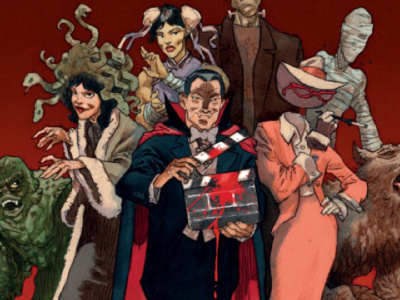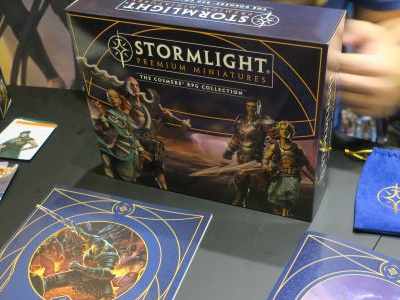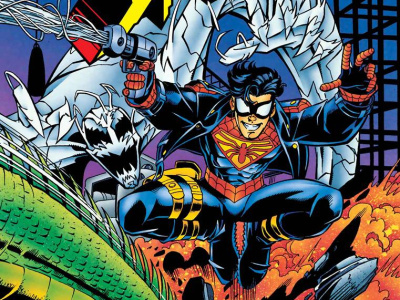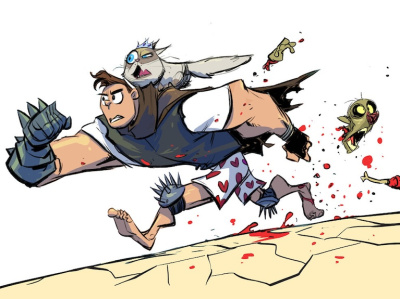
Interview conducted November 29, 2000 in Timonium, Maryland.
1.What did you do before you joined Diamond? I worked for ten years at McDonald's fast food and learned a lot about management while I was earning my college degree. After ten years at McDonald's I decided I needed to do something else and ended up getting a job with Mile High Comics. I moved from Mile High to Alternate Realities, and from there to Bud Plant.
Do you think your McDonald's training helped you with what you did at Diamond? Absolutely. McDonald's has a very solid management training program. This training program gives them the ability to have cookie-cutter locations that are run very similarly no matter where you go. I got as much, if not more, out of my McDonald's management training as I did from my four year college degree.
2. How long have you been with Diamond? Steve [Geppi] bought Bud Plant in July of 1988.
3. Describe your career path since you joined Diamond. At the time I was running the Hayward/San Francisco warehouse, where I stayed for about a year. During this time, through the Bud Plant transition and other expansion more and more warehouses were being opened. At that time, Chuck [Parker] was handling all operational issues along with numerous other areas.A decision was made that we needed someone full-time to concentrate on operations, so sometime in '89 we created this new position. I don't believe it started as a vice president position. When the position was posted internally, I applied and was accepted. So after about a year in San Francisco I came here to the home office and I've been doing operations since then. It's been over ten years now. The job has changed somewhat in terms of which departments flow through operations and what the title has been, but it has always been a concentration on people, systems and efficiencies.
4.What are your current responsibilities? Diamond, from an operations standpoint is the distribution centers, the transportation department, and the order-processing department. Order processing for us is order entry and purchase order functions, as well as some data issues that revolve around our computer system.
5.How many distribution centers do you have? We currently have five in the U.S. and one in the U.K.
6.Do some prepare goods for other DCs as well as for accounts? We have our centralized hub location, which is Sparta, and they do a lot of preparations for other locations. Sparta doesn't actually service any new products to customers. Each of our customers is assigned to one of our other four locations in the U.S. Sparta handles a large portion of our inventory as well, so they process our direct ship reorders.
7.How do you get products into your DCs? Just about every transportation mode you can think of. We move some product on our own trucks so we can better control the timing. Some product moves on common carriers or 'LTL,' less than truckload shipments. UPS, Fedex, and other small package carriers deliver to all our centers. We bring product in from the Orient on ocean carriers, and we still use a little bit of air freight to move product to the west coast.
8.How are products prepared for shipment to accounts? In our four distribution centers (not Sparta), we have what people would probably think of as an assembly line or roller process. From there it is basic distribution, taking multiple items in large quantities and breaking these down to smaller quantities for shipment to our customers. (Too bad it isn't as easy as that sounds!).
9. How do the accounts get their goods? In rough numbers, about eight-five per cent of our customers use UPS.
10. What percentage of the product is picked up at Diamond's local warehouses? About ten per cent of our customers pick up at our five distribution centers or one of our thirteen drop points. The remaining few percent get books via LTL (less than truck load carrier) or some other mode of transportation.
11. Can retailers shop at the Diamond warehouses? Yes, but we don't get a lot of this for two reasons. First, the majority of our inventory sits in Sparta, and not many of our customers visit Sparta. We house only a small amount of inventory at the local level. Second, just because it's sitting on the shelf doesn't mean the product is available. We have an online inventory system, so product is confirmed to a customer before it is actually picked. So, if a customer does shop, they have to write down what they want and an employee then checks the computer system to make sure it hasn't already been sold to somebody else. If a customer does wish to shop, we ask that they call ahead and make an appointment.
12. There's been some discussion among retailers about changing the Wednesday release date for Diamond shipments. Would such a change represent a big challenge to your logistics network? The simple answer is yes. We organize our entire logistics operation around the current release date. However, we are capable of changing. The real issue is getting any kind of agreement on what the new day should be. I believe the last time we polled our customers, the majority preferred the current Wednesday release.
13. So the day of the week really wouldn't matter if you could get people to agree? That's correct. Once I had a day, I'd have to look at all the issues. You have probably heard some people saying it should be Friday so it is closer to the weekend. One of the drawbacks to this is that eighty five per cent of our customers are moving via UPS. While UPS is very accurate, if you have a package that's delayed and you're getting a Friday delivery, you're losing the weekend. I would not recommend moving the release date to the end of the week.
14.How does Diamond deal with damage to high dollar items such as statues? Customers should report them right away and we give them credit on the next available invoice. A replacement is sent the next week, if we've got one in inventory. Our purchasing department works closely with manufacturers of these type items to make sure they are packaged properly. Even with these efforts, there are occasional problems. If we find we're getting a lot of breakage, the vendor and our purchasing department work together to find the best solution.
15.What kind of changes in picking and packing procedures have been necessitated by the growth of sales of toys, models, and statues vs.; publications of relatively standard size? The biggest change has been from a packaging angle. We've had to go to multiple box sizes, as well as determining the best type of dunnage (i.e., peanuts, shredded paper, butcher block paper, etc). Recently we started using an 'outer wrap' for our toy cases at the suggestion of a retailer. It's been really helpful. By utilizing this toy wrap we've really reduced damages. We have also developed several new boxes that allow us to ship different types of product (blister packs and comics) together in the same box. This helps to reduce the number of packages and thus reduces the cost of freight.
How do you wrap those assortment boxes? Essentially, we use a flat piece of cardboard that you wrap around the case of toys. Within reason, you can have multiple case sizes and use the same size wrap. One extra layer of cardboard around the box makes a big difference.
16.Diamond is one of the leading importers of both Japanese language publications and toys produced for the Japanese market. How do you deal with the occasional lack of clear English titles or product names on the packaging? Anything that is not easily identifiable, we bag and sticker with the Diamond item code.
17.Many problems stem from the lack of standardized numbering and/or bar coding, making it difficult to track by sku at checkout. What challenges do you see in implementing a Diamond program of labeling products you sell that don't already carry a UPC or other standardized code? The problem with coding is that it's very labor-intensive if we have to add bar codes after the fact, especially to a comic book. Is it possible to get a return on your investment in this situation? Many of the retailers that we service are not the Wal-Marts of the world. They're not using systems in their stores that are going to utilize bar codes.
Isn't it a sort of chicken or the egg situation? There's little incentive for retailers to do it because there are so many products that aren't coded. Can Diamond use its bully pulpit to get these small press publishers in line? I think it's a much better use of our time to try and get publishers to put bar codes on product than for us to add the bar codes. Our purchasing dept has been doing this and they will continue to do so.
18.To what degree are your logistics decisions driven by cost vs. speed? Where are your customers' greatest concerns? It's always a balance between cost and speed. The faster you have to go, the more expensive the freight costs will be. Speed is especially important with items that are going to be available in a mass-market store. In the ideal world, we want these items to arrive to our customers before or at the same time as they arrive at the mass-market stores. If it's an exclusive item that's only going into the hobby market, and the item arrives this week rather than last week, it's not nearly the issue.
19.How do you handle varying release dates in different product categories, such as videos and trading cards? For new products, we have one release date a week. Most all customers get their products on Wednesday. We have experimented with other release dates, most recently with WOTC (Wizards Of The Coast) products that had a Monday release date. We've offered all our customers the option of getting these products on Monday. Very few customers have asked to participate in this program. I believe this is because they would rather wait until Wednesday and save a bit on freight charges.
20.Does Diamond offer same-day shipments for backlist orders received in the morning? Any order posted by one p.m. EST will ship from our Sparta location the same day.
Thank you, Cindy.







